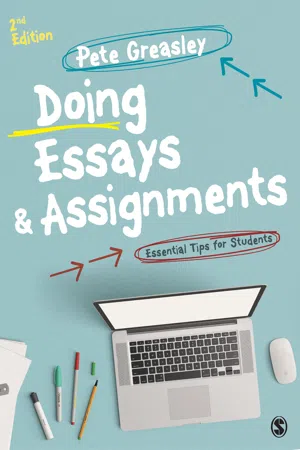
- 240 pages
- English
- ePUB (mobile friendly)
- Available on iOS & Android
About this book
Have you ever been stunned by a low grade, when you were expecting an A or B?
Are you struggling to make the jump from a second to a first?
Doing Essays and Assignments gives you an insider's view on what tutors and professors really want when they assign essays and projects, and reveals how you can raise your game and achieve the best grades.
Drawing on a survey of lecturers, and examples of real student work, this handy guide provides practical advice to help you not only understand what is expected of you, but also get ideas on how to deliver what your tutor is looking for. Providing a behind-the-scenes look at marking, find out how you can successfully craft the perfect written assignment, and discover tips and techniques on:
- Planning and deadlines, helping you manage your workload effectively
- Gaining higher marks through critically formed arguments
- Communicating clearly with the correct language, grammar, and expression
- Avoiding common marking pitfalls such as referencing and plagiarism.
This new edition also reveals how to successfully navigate group work, literature reviews, and presentations to improve your grades.With valuable insight from tutors, and practical tips to apply to your work, you might just want to keep this book to yourself…!
SAGE Study Skills are essential study guides for students of all levels. From how to write great essays and succeeding at university, to writing your undergraduate dissertation and doing postgraduate research, SAGE Study Skills help you get the best from your time at university. Visit the SAGE Study Skills hub for tips, resources and videos on study success!
Frequently asked questions
- Essential is ideal for learners and professionals who enjoy exploring a wide range of subjects. Access the Essential Library with 800,000+ trusted titles and best-sellers across business, personal growth, and the humanities. Includes unlimited reading time and Standard Read Aloud voice.
- Complete: Perfect for advanced learners and researchers needing full, unrestricted access. Unlock 1.4M+ books across hundreds of subjects, including academic and specialized titles. The Complete Plan also includes advanced features like Premium Read Aloud and Research Assistant.
Please note we cannot support devices running on iOS 13 and Android 7 or earlier. Learn more about using the app.
Information
1 An insight into the marking process
- The importance of bearing in mind that your tutor will have lots of assignments to mark and limited time to mark them
- The marking process at universities (which may involve up to three stages)
- Consistency across markers, and why some inconsistency might actually be a good thing
- Different types of markers (‘hawks’ and ‘doves’), and sources of bias that can influence the mark you’re awarded (including what you look like)
- How the transition from school/college to university may be a culture shock for some students
Marking assignments: four in an hour?
- all the courses I taught (there were five courses with a total of seven written assignments)
- the number of words for each assignment (most were 2,000 words, but some were 8,000; the average worked out at around 3,000)
- the number of students on each course (200 students in total)
The marking journey: a ‘smooth ride’ or a ‘bone-shaker’?
The learning journey: are you a hitch-hiker, an explorer, or just plain lost?

An insight into the marking process
- Step 1: First marking. Usually by your course/module tutor.
- Step 2: Internal moderation. ‘Moderation’ refers to the process for ensuring that marks awarded are fair, consistent and reliable. It’s more commonly known as second marking or double-marking by another tutor.
- Step 3: External moderation. Where a tutor from another university (an ‘external examiner’) comments on the marks awarded.
Step 1: First marking
- Tutor comes into work to find four piles of assignments on his desk, each over a foot high
- Tutor takes gun from holster and puts to head (or…)
- Tutor takes essays home to mark the next day
- On a nice summer’s day, tutor sets up sun-lounger in back garden and settles down to marking (with increasing quantities of ‘liquid refreshment’)
- Tutor gets half-way through first assignment and scuttles back indoors due to: electric chainsaw, house alarms, barking dogs, gusty wind blowing pages everywhere …
- Having read the assignment and made notes, the marking grid is consulted and the marks are entered accordingly, along with copious written feedback helping the student to address the identified areas of deficit. Repeat 100+ times.

Step 2: Second marking (in moderation)
Table of contents
- Cover
- Half Title
- Publisher Note
- Title Page
- Copyright Page
- Contents
- Illustration List
- Table List
- About the Author
- Preface to the second edition
- Acknowledgements
- Why you should read this book (and keep it to yourself)
- 1 An insight into the marking process
- 2 How to impress and how to distress markers
- 3 Before you start, some rules of the game
- 4 Getting started … and getting finished
- 5 Reading and researching the literature
- 6 Introductions, conclusions and structure
- 7 What was the question again?
- 8 Critical analysis, perspective and argument
- 9 The greatest source of ‘marker distress’: language, grammar and expression
- 10 Referencing – an academic fetish for the anally retentive?
- 11 Plagiarism
- 12 How not to present graphs and charts
- 13 Presenting your assignment: first impressions count
- 14 Feedback and feed-forward
- 15 Writing research/project reports
- 16 Doing a systematic literature review
- 17 Presentations: a fate worse than death?
- 18 Group project work, or ‘hell is other people’
- References
- Index